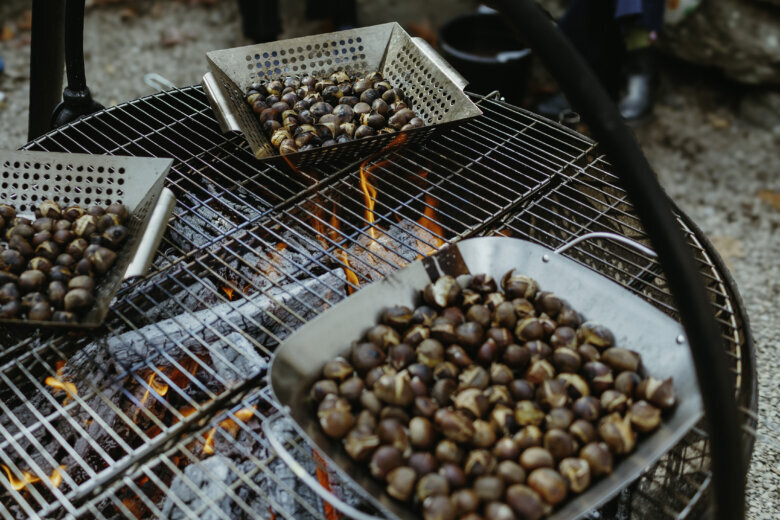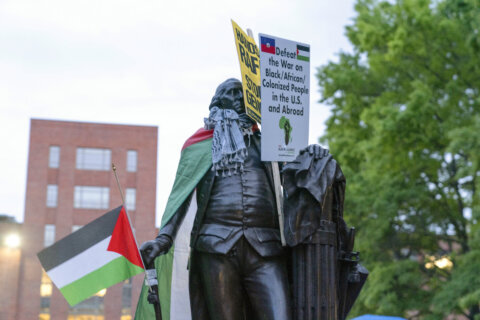
In the panoply of smells that mark the transition of fall into winter, few are more evocative than chestnuts roasting on an open fire.
The aroma that inspired the first line of Mel Torme’s “The Christmas Song” emanates from the U.S.’s once-thriving nut tree crop, which was devastated by a 1900s-era blight.
Now, in 2023, there’s a push to help plant 1 million nut trees in the mid-Atlantic.
Michael Judd, co-founder of SilvioCulture, Inc. — a Maryland-based nonprofit seeking to partner with landowners, farmers, investors and other stakeholders — said the smell of chestnuts roasting is alluring.
“Chestnuts remind me almost of a sweet potato on a tree,” Judd said. “You get this sweet — both aromatic and tasting — nut.”
Some have first experienced roasted chestnuts on a New York City pushcart, with hot pretzels stacked nearby.
“It’s very easy to create a set of coals to roast chestnuts,” Judd said. “Across Europe and Asia, this is a very common street food — of course, in the wintertime everyone wants to gather around a warm spot.”
Judd said chestnuts can be grown across most of the temperate world.
“You have the American chestnut, the European chestnut, the Japanese chestnut and the Chinese chestnut,” Judd said. “They’re gorgeous. They’re chestnut brown, as you might imagine. And they produce this spiky burr, which is great, because you get a chance to get at the nut before the squirrels and other animals do, if you open it with your feet or some gloves.”
What happened to chestnuts in America
The push to plant 1 million nut trees seeks to reestablish a once-prominent crop of chestnut trees in the area.
“Chestnut trees were the dominant tree nut species — some estimates were that one of every four trees was a chestnut,” Judd said. “And then, around the turn of the 1900s, a blight came in from Asia.”
After first being discovered at the Bronx Zoo in New York City in 1904, 4 billion American chestnut trees were killed by the deadly fungus.
“The government forestry department decided to go in and cut the rest down, to try to avoid the spread of this, but that may have included some of the trees that may have proven to be resistant,” Judd said.
Plans for the future of chestnut trees in the mid-Atlantic
Judd said the positive effects of nut trees can’t be overestimated.
“Nut trees feed the ecosystem. They’ve been critical, especially during times of inclement weather, of war, of times of challenge, the nut tree has seen humans through very challenging times,” Judd said.
“You plant it once, and it lives for years. We’re talking about chestnuts, so we’re talking about hundreds of years.”
In addition to feeding humans and animals, decades-old nut trees also feed the environment.
“You’re improving the water cycles, the air quality, and building habitats,” Judd said. “You’re doing all these benefits, and you’re producing an abundance of a very valuable food that is nutrient-dense.”
Judd said the American Chestnut still exists, but lives mostly in the soil.
“The root system exists and sends up shoots — typically it’ll grow for about six years before the blight starts to affect it.”
However, other chestnuts continue to thrive in the U.S.
“We’re working with genetics, mostly from the Chinese chestnut, which does very well in the mid-Atlantic and most parts of the U.S., and is resistant to the chestnut blight, so it stays very productive,” Judd said.
Investment in the future of chestnut trees pays long-term benefits.
“The chestnut will produce every year. That’s why it’s a dependable food security.”
In addition, nut trees can be lucrative for mid-Atlantic farmers.
“The U.S. is importing upwards of 88% of the chestnuts it’s consuming.”
Since chestnuts are in high demand, with a relatively high price, Judd said nut tree farmers can do well financially.
“You could be earning anywhere from six-to-$30,000 per acre for growing chestnuts, which blows away almost any other crop in the states.”
However, future success depends on planning and patience, even after the young trees are planted.
“An average time is six years to begin production on chestnuts,” Judd said. “By 10 years, you’ll recoup your costs, and by year 15, you’ll really be getting heavy harvest, anywhere from 75 to 100 pounds of chestnuts per tree.”









